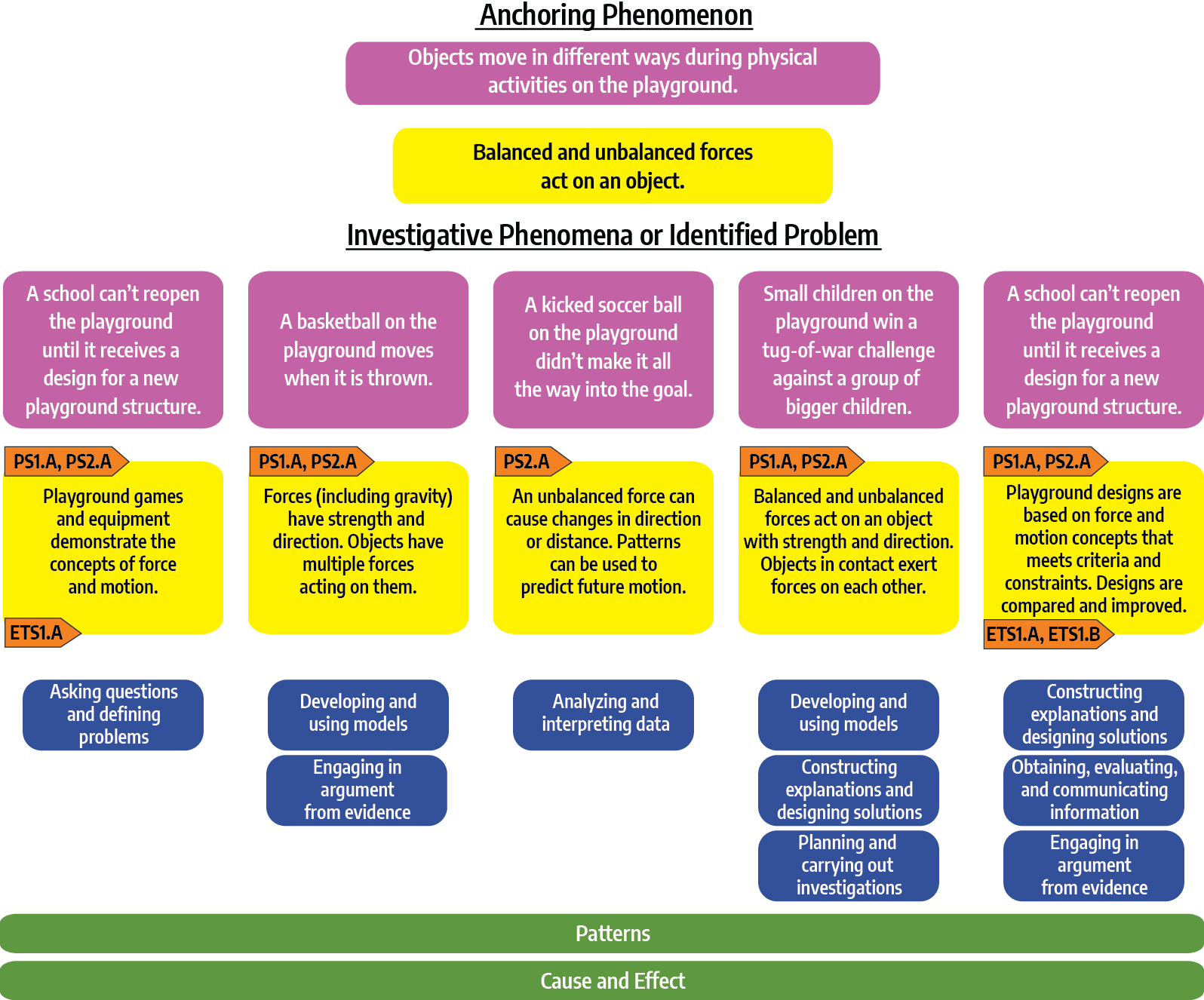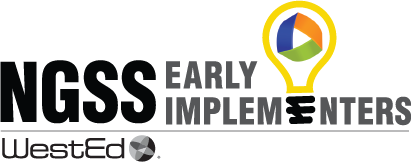
After completing this unit, students will never look at recess or physical education the same way again. The anchoring phenomenon for this unit is objects move in different ways during physical activities on the playground. This unit is the first half of the third grade Physical Science standards and addresses the first two Performance Expectations only. In this unit, students identify forces and that forces have strength and direction. While exploring the playground, students observe the action of contact forces by investigating how balanced and unbalanced forces cause motion as well as how speed and direction changes are caused by the strength and the direction of the force. Students also incorporate their observations of patterns to predict the future motion of objects when a force is applied. The students complete this unit by using their knowledge of force and motion on the playground to design a new playground structure or activity.
The Performance Expectations (PEs) addressed in this unit are:
| 3-PS2-1 | Plan and conduct an investigation to provide evidence of the effects of balanced and unbalanced forces on the motion of an object. [Clarification Statement: Examples could include an unbalanced force on one side of a ball can make it start moving; and, balanced forces pushing on a box from both sides will not produce any motion at all.] [Assessment Boundary: Assessment is limited to one variable at a time: number, size, or direction of forces. Assessment does not include quantitative force size, only qualitative and relative. Assessment is limited to gravity being addressed as a force that pulls objects down.] |
|---|---|
| 3-PS2-2 | Make observations and/or measurements of an object’s motion to provide evidence that a pattern can be used to predict future motion. [Clarification Statement: Examples of motion with a predictable pattern could include a child swinging in a swing, a ball rolling back and forth in a bowl, and two children on a see-saw.] [Assessment Boundary: Assessment does not include technical terms such as period and frequency.] |
| 3-5-ETS1-1 | Define a simple design problem reflecting a need or want that includes specified criteria for success and constraints on materials, time, or cost. |
| 3-5-ETS1-2 | Generate and compare multiple possible solutions to a problem based on how well each is likely to meet the criteria and constraints of the problem. |

The Learning Sequence Narrative briefly describes what students do in each lesson and links the learning between the lessons as a conceptual storyline. At the end of each learning sequence, students make connections to their understanding of the investigative phenomenon and/or the identified problem (and to the anchoring phenomenon when appropriate).
The anchoring phenomenon for the learning sequence is objects move in different ways during physical activities on the playground.
Students figure out this phenomenon by:
Asking Questions and Defining Problems
Developing and Using Models
Planning and Carrying Out Investigations
Analyzing and Interpreting Data
Constructing Explanations and Designing Solutions
Engaging in Argument from Evidence
Obtaining, Evaluating, and Communicating Information
PS2.A: Forces and Motion
PS2.B: Types of Interactions
ETS1.A: Defining and Delimiting Engineering Problems
ETS1.B: Developing Possible Solutions
Patterns
Cause and Effect
Influence of Engineering, Technology, and Science on Society and the Natural World
The following Learning Sequence Narrative is based on the conceptual flow concept map above.
This lesson builds on students’ observation that objects move on a playground (anchoring phenomenon) and introduces students to a real-world problem: the scenario of a playground that needs to be redesigned. Students discuss why playgrounds are important, make observations of movement on the current playground, and use those observations to determine initial criteria to meet the design challenge of creating a new playground. They also determine initial investigation questions to gather evidence to support their design. Students explore forces and motion with such questions as: What is the movement? What caused it to move? How does it apply to our identified problem?
This lesson builds on students’ prior knowledge shared in Lesson 1: Movement on the Playground. In this lesson, students explore the three questions from Lesson 1 as they investigate the cause and effect of various characteristics of forces using the playground game of basketball. Students use a model to show that forces have strength and direction. Students are also introduced to the force of gravity. They discuss cause-and-effect relationships to move a basketball and look for patterns in motion.
In Lesson 2: Forces Move Objects, students created models to show balanced and unbalanced forces based on the knowledge gained through basketball experiences. In this lesson, students build on these fundamental understandings of force and motion and apply them to a soccer ball. They continue to explore the three questions from Lesson 1: Movement on the Playground as they analyze and interpret data about how strength of the force impacts the distance the soccer ball moves. They apply the patterns of motion and cause-and-effect relationships to predict team players and their success for a new soccer game for the new playground.
In Lesson 2: Forces Move Objects and Lesson 3: Patterns in Motion, students continued to build on the fundamental understandings of force and motion using balls. In this lesson, the students work with a non-ball example (tug-of-war) to continue to think about the cause and effect of balanced and unbalanced forces on an object as well as the strength and direction of the force. They also look for patterns in motion. They apply these understandings to the design of the playground.
This lesson builds on the student data, knowledge, and explanations of force and motion gained in the prior lessons. This is the culminating lesson in the learning sequence. This lesson introduces the concepts of engineering design and the use of forces and motion to solve a problem. The previous lessons had students constructing explanations and models about the cause and effect of forces by observing patterns and collecting data from their investigations. Students will use this information to design and construct a new playground activity or piece of equipment to help solve the problem of replacing an old, unusable playground structure.
The Grade 3: Playground Forces unit provides multiple and ongoing strategies for teachers to assess student understanding as they progress toward mastery of Performance Expectations. These include:
 ). Throughout the lessons,
these are often formative assessments. Sometimes the Evaluate phase might serve as a
summative assessment.
). Throughout the lessons,
these are often formative assessments. Sometimes the Evaluate phase might serve as a
summative assessment.Lesley Gates, Former NGSS Early Implementers Project Director, Kings Canyon Unified School District
Craig Groschup, 3rd grade teacher, Core Leadership Team, Vista Unified School District
Susan Ritchie, Former NGSS Early Implementers Project Director, Vista Unified School District
Lorena Sanchez, 3rd grade teacher, Core Leadership Team, Tracy Unified School District
Cecilia Ochoa, 3rd grade teacher, Core Leadership Team, Lakeside School District
Heather Trovinger, 3rd grade teacher, Galt Joint Unified School District
Craig Groschup, 3rd grade teacher, Core Leadership Team, Vista Unified School District
Lorena Sanchez, 3rd grade teacher, Core Leadership Team, Tracy Unified School District
Achieve Science Peer Review Panel

A Collaboration of the K-12 Alliance @ WestEd, Aspire Public Schools, Galt JUSD, High Tech High, Kings Canyon USD, Lakeside USD, Oakland USD, Palm Springs USD, San Diego USD, Tracy USD, Vista USD, Achieve, and the California Department of Education
with funding from the S.D. Bechtel, Jr. Foundation and Hastings-Quillin Fund
The California K–8 NGSS Early Implementation Initiative was developed by the K–12 Alliance at WestEd with close collaborative input on its design and objectives from the California State Board of Education, the California Department of Education, and Achieve. This project was designed to build local education agency (LEA) capacity to fully implement the Next Generation Science Standards (NGSS) as a core subject in the elementary grades (K–5) and as the SBE’s preferred integrated model in grades 6–8.
The six-year Initiative provided teachers and administrators with in-depth, content-rich professional development to build leadership capacity and teacher acumen to deliver high-quality 3-dimensional learning for K–8 students. In addition, through collaborations among the K–12 Alliance, Achieve, and others, the LEAs in the Collaborative have opportunities to pilot test new NGSS-aligned tools, processes, assessment item prototypes, and digital and other instructional materials. The LEAs continue to serve as resources for NGSS implementation across California, and in other NGSS-adopting states as well.
This resource presents the conceptual storyline for a unit of instruction at a specific grade level, then focuses on a portion of the storyline called a learning sequence. The learning sequence uses the 3 dimensions of the NGSS (disciplinary core ideas‐DCI; science and engineering practices‐SEP; and crosscutting concepts‐CCC) to build and deepen student understanding of natural phenomena and design challenges.
Participants in the CA NGSS K–8 Early Implementation Initiative developed and field-tested the lessons in the learning sequence.
NGSS Lead States. 2013. Next Generation Science Standards: For States, By States. Washington, DC: The National Academies Press.
A Framework for K–12 Science Education: Practices, Crosscutting Concepts, and Core Ideas. DOI: https://doi.org/10.17226/13165. National Research Council; Division of Behavioral and Social Sciences and Education; Board on Science Education; Committee on a Conceptual Framework for New K–12 Science Education Standards. National Academies Press, Washington, DC.